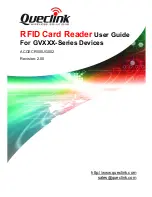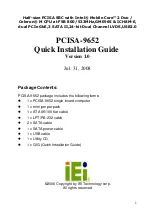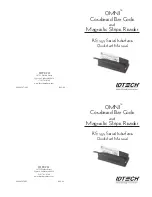
8
ENGLISH
ENGLISH
The following instructions must be respected:
•
Lay the loops at least 15 cm. from fixed metal objects.
•
Lay the loops at least 15 cm. from fixed metal grilles.
•
Lay the loops at least 50 cm. from moving metal objects.
•
The loops must be laid at a depth of 30mm. to 50mm. from
the road surface.
•
The loop must be made with a single cable, without making
any joints or shunts inside the pits.
•
The two ends of the cable issuing from the loop perimeter
must be twisted or intertwined with each other at least 20 times
per meter, up to the connection inside the Ticket Reader.
•
The twisted cable of the loop must be laid in pipes or cable
ducts separated from those used for other purposes (power
etc.).
2.3.2 CONSTRUCTION
The shape of the loops must be ‘rectangular’. The corners
must be cut at 45° to prevent the cable breaking, due to the
vibrations of transiting vehicles or possible settling of the road
paving.
There are two methods for making them:
•
Lay a single single-pole cable with a cross section of
1.5 mm
2
, with double insulation, directly in a chase made in
the existing road paving.
•
First construct a cable duct in PVC of the necessary shape,
insert a single-pole single-insulation cable with a cross-section
of 1.5 mm
2
inside it, and then lay the loop thus constructed
inside the chase.
NB.: in both cases, respect the requirements specified in point
2.3.1.
described up to here, around the perimeter in which it must be
constructed.
Procedure for the above operation: insert the cable end from
the sharp edge providing access into the chosen seat, next run
it inside for a set of full ‘circuits’, to make a coil, and then
make the same cable come out from the point where it had
been inserted.
Fig. 3
The windings which must be made in order to construct the
loop correctly, depend on the dimension of the perimeter.
The dimensions of the loops to be laid on the lane managed by
the Ticket Reader, shown in the following chapters, call strictly
for the construction of
4 windings
.
In fact, the system detects all the transit stages of the vehicles
on the entrance lane, making use of these devices. As a result,
fewer than specified windings will not make the equipment,
assigned to control the lane, operate correctly.
NB.: if there are metal nets under the paving (see the distance
of the metal grilles previously referred to), we advise you to
add 2 windings to the 4 obligatory windings.
Fig. 4
Loop consisting
of 4 windings
2.3 CONSTRUCTION OF LOOPS
2.3.1 INSTALLATION
2.3.3 NUMBER OF WINDINGS
The loop must consist of a precise set of windings of the cable


































